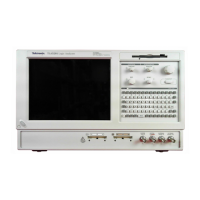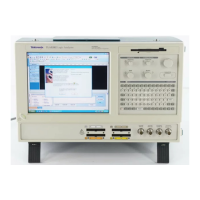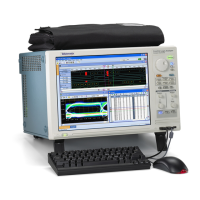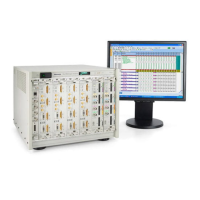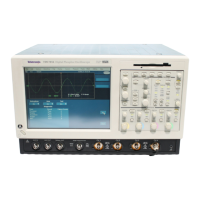Theory of operation
DC probe calibration
P7700 Series pr
obes and TekConnect host oscilloscopes support a DC probe
calibration process for optimizing pro be DC Gain and O utput Zero performance.
The DC probe calibration operation uses a standard accessory test fixture
(Tektronix part number, 067-4889-00) that automates the process. The calibration
process uses a programmable DC voltage source available on the oscilloscope
front panel. The oscilloscope DC Probe Cal voltage source is connected to and
drives a DC P
robe Cal test fixture input. The DC Probe Cal test fixture buffers
and switches the voltage source signal, as required for the different input modes
and step gain settings, to the attached P7700 Series probe tip inputs. The DC
Probe Cal voltage source is swept over the probe tip input voltage range as the
resulting probe output voltage is measured by the oscilloscope. This combined
probe and oscilloscope configuration forms a closed loop measurement s ystem,
which is u
sed by the oscilloscope to measure gain and output zero errors. The
oscilloscope adjusts its vertical channel gain and offset controls to correct for the
measured probe signal errors. The DC prob e calibration procedure is described in
the P7700 Series User Manual.
Solder-in tip connection
wire length
There are four via locations for soldering wire connections between the probe
tip and the measurement DUT.
The via connections include the probe tip A and B inputs for a differential signal
and two ground connections for best performance and flexibility in connecting to
a close DUT ground. In general, the probe tip soldered wire connection length
should be kept as short as possible. I n addition, the probe tip A and B input wires
should be matche d in length for bes t differential mode measurement performance.
The differential input mode does not require a ground reference wire connection,
since the differential measurement process provides its own virtual ground. The
single-ended input modes, which include A-GND mode, B-GND mode, and
common mode, all require at least one ground wire connection.
While only connecting the differential inputs of the probe is required and is most
convenient, if there is room for another connection and a circuit ground near the
probe tip, connecting to a ground connection is recommended. Connecting the
ground can help avoid a situation where a large potential on the ground of the
DUT causes the test signal to drift outside of the linear range of the input amplifier
of the probe. Ideally, it is a good idea to connect the differential inputs and the
ground to avoid clipping of the signal in the probe amplifier.
The measurement performance of all input modes is affected by the length of the
input wire connection, with high frequency performance degradation increasing
with increased wire length.
The measurement performance of the single-ended input modes is affected by
the length of the ground wire connection, with high frequency performance
degradation also increasing with increased ground wire length. The P7700 Series
solder-in probe tip performance is specified using a test fixture built with a probe
tip having a signal wire length of 10 mils (.25 mm) and a g round wire length of
66 mils (1.7 mm).
22 P7700 Series TriMode Probes Technical Reference

